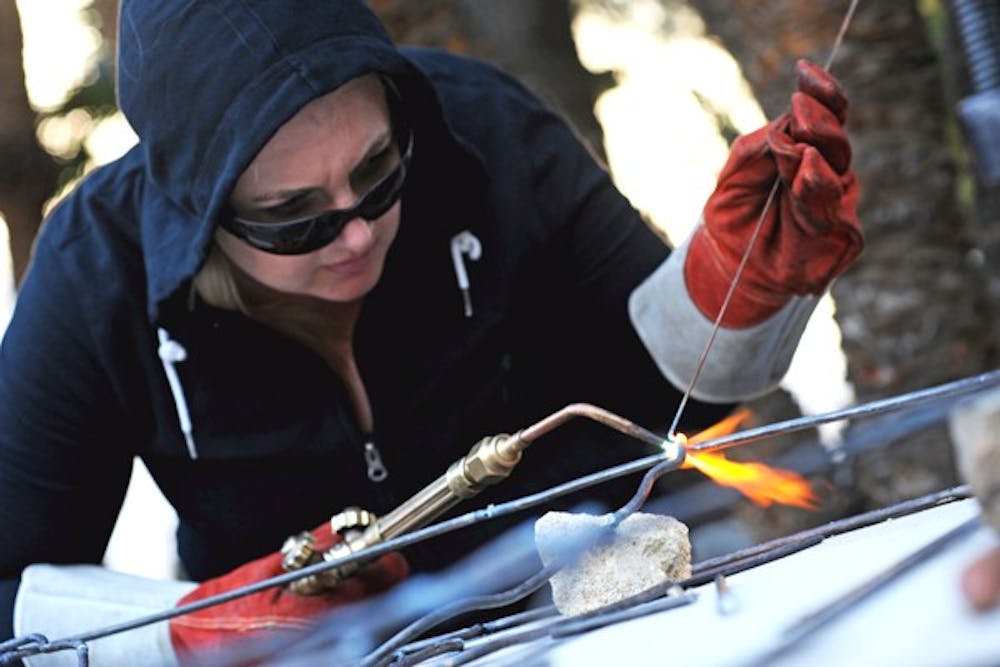 (Photo Courtesy of Tim Trumble)
(Photo Courtesy of Tim Trumble)For students in visually creative fields, learning often takes on a different form. Instead of copious notes and hours spent in a library, students at the School of Art are exploring their creative side with printmaking classes, ceramic arts, photography and more.
All this is being done in a program that was recently ranked as one of the top fine art programs in the country. In the 2014 U.S. News & World Report annual rating of the nation’s best colleges and universities, ASU’s School of Art in the Herberger Institute for Design and the Arts was ranked 22nd among graduate schools of fine arts, fifth for it’s printmaking program, seventh for ceramics and 11th for its photography program.
The rating is based on a 2011 peer assessment survey conducted by art school deans and other faculty members at 230 master of fine arts programs in art and design from across the country.
“It’s great that the incredible efforts of our faculty and staff in supporting and fostering high-quality programs is being recognized, along with the talents of our alumni,” said Adriene Jenik, director of the School of Art.
Photography professor and associate director Julie Anand attributes the success of the school and its ranking to the talented faculty, variety of classes and unique opportunities offered to students.
The faculty of the School of Art includes artists that specialize in many fields. Ceramics professor Kurt Weiser was a recent recipient of one of 50 fellowships awarded to artists across the nation by the United States Artists foundation and one of its unrestricted $50,000 grants. Because of this award, Weiser said he is able to afford the supplies needed for his work, which offers him more freedom with ceramics.
With regards to what makes the School of Art’s program stand out compared to others in the country, Weiser said it is the dedication of the faculty that makes the school a success.
“The program has evolved slowly; it hasn’t happened over night,” Weiser said. “It happened mostly with the addition of new people and the change is a product of the people that teach here. “
 (Photo Courtesy of Tim Trumble)
(Photo Courtesy of Tim Trumble)An evolving program
When Jenik joined the School of Art as the director several years ago, she worked to bring the school together as one interdisciplinary whole, Anand said. One change has been new hires.
“We have what we call bridge builders, and their work is hybrid,” Anand said. “They have the ability to make connections between, for example, video and ceramics or printmaking and photography. We also have our senior faculty who specialize in a deep skill set.”
Professors that specialize in range of fields are instructing the hybrid classes, she said. These classes might be something that combines photo and printmaking, for example, to encourage students to create work that synthesizes the two. It is a newer method of teaching that helps move the school toward a more contemporary approach of art.
There have also been specific changes to some of the programs, including the addition of new classes.
“We also have a strong intermedia program that allows student to study art that doesn’t fit in the standard forms of media, such as performance art," Anand said.
“Gregory Sale is the newest hire in intermedia, and he has really gotten students involved in the community. Most recently, his class Art and Community participated with Feast on the Street in downtown Phoenix, and this was a great way to make his classes do something tangible that is involved with the community," she said.
The faculty encourages students to interact with the artists in their community, Anand said. One program called the Map(ing) project, developed by associate professor Mary Hood, brings native artists and students together to collaborate with printmaking.
“The prints are beautiful, but the project is more about the cultural exchange between the native artists and the students,” Anand said. “Students work as guides to help translate the art into print forms. The project gives students the opportunity to harness the rich traditions already here in the southwest."
Anand said the School of Art also created a new minor, studio art, which is open to students of any major who wish to take studio classes, such as painting or ceramics.
“Imagine how 3-D Computer Imaging and Animation, Neon Sculpture and Foundry Casting Methods could serve an engineering student's learning and research; or how creative writing students might enjoy Papermaking, Artists' Books and Art on Paper,” she said.
The minor offers more students the chance to delve into creative fields that will benefit their current major she said.
Offering variety in the Southwest
 A student molds clay in her ceramics class. She is currently exploring ASU's art program before deciding if she will continue for an Masters degree in Fine Arts. (Photo by Ashley Kesweder)
A student molds clay in her ceramics class. She is currently exploring ASU's art program before deciding if she will continue for an Masters degree in Fine Arts. (Photo by Ashley Kesweder)The School of Art program was the only program in Arizona to rank in the top 25 on the 2014 U.S. News & World Report. Its undergraduate program is largely made up of in-state students and students who change majors, said ceramics professor Susan Beiner, while the graduate program attracts applicant’s from across the country.
“Graduate students really apply to the program because of our ranking, because of the diversity that exists in the program and (because) we have a wonderful facility in a beautiful place,” Beiner said. “Most of the graduate students are not local; they are from out of state, and that means we are competitive with other schools, because we do get a healthy pool of applications.”
Printmaking professor Rogelio Gutierrez said graduate students in the School of Art have the uncommon opportunity of a great amount of teaching experience.
“Our graduate program has students teaching other students, and what is pretty unique is the graduate students get to teach when they start,” Gutierrez said. “They can get up to three years of experience while in school where with other programs across the country students might only get a semester of teaching.”
Beiner said the main challenge that the school is facing right now is how to bring in the top caliber of graduate students with a decreasing budget.
“Funding is always a challenge, and with the graduate program, less funding makes it more difficult to bring in the top students,” Beiner said. “As budget goes down, we can’t get new equipment, and we can’t keep up with kilns and things like that.”
Despite these challenges, Beiner said the school is finding several ways to make unique learning experiences available to students. She said the ceramics program in the past has brought student to the National Council for Education of the Ceramic Arts conferences and Sculpture Objects Functional Art in New York. This summer, the program will be taking six graduate students to Hungary to work and travel, offering students an international learning experience.
Ceramics senior and president of the Clay Club, Ashley Mudd, said her club works with the business side of art to raise money so club members can attend NCECA.When she joined the club in 2010, the members had raised enough money to cover a travel stipend for the trip, and now they are able to completely cover the costs to send members. She said this is done through fundraising events such as a silent auction done in the spring in conjunction with the ASU Art Museum.
Mudd said she was attracted to the School of Art because of the reputation of the Herberger School and the amount of opportunities for community involvement offered by the art program.
“A lot of us undergrads are still figuring out the fundamentals and finding out where we want to specialize on top of learning as much as we can,” Mudd said. “There is a lot of encouragement throughout the studio to participate with things going on outside the school such as internships or residencies and other outside activities.”
After graduation in May, Mudd said she plans to continue her study in ceramics in Montana at the Archie Bray Foundation for the Ceramic Arts. She will be doing an apprenticeship with the gallery director at her production studio.
In addition to a strong faculty and a comprehensive array of classes available to students, the location of the school contributes to its success, Anand said.
“Something that sets us apart from other schools is that we are located in the desert, which has interesting potential for students who want to think about their own relationship to a resilient environment,” she said.
Weiser agreed that the location is something that draws students from across the country to the program.
“There’s a lot going on here; people come from all over the country,” he said. “The Southwest is sort of a frontier, not in the covered-wagon sense, but there is a lot of tolerance for new ideas.”
 (Photo courtesy of Tim Trumble)
(Photo courtesy of Tim Trumble)
Reach the reporter at newlin.tillotson@asu.edu or on Twitter @Newlin777




